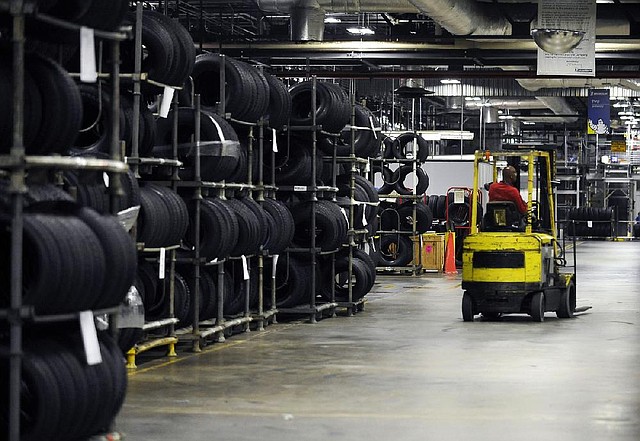Factory orders up 2.8% in July
But investment gauge declines
A forklift driver takes inventory into the warehouse at a Michelin tire plant in Greenville, S.C., in July. Factory orders rose 2.8 percent in July, the Commerce Department said Friday.
Saturday, September 1, 2012
LITTLE ROCK — Orders to U.S. companies rose in July, reflecting a surge in demand for autos and commercial aircraft. But in a troubling sign of manufacturing weakness, a key orders category that tracks business investment plans fell by the largest amount in eight months.
Factory orders rose 2.8 percent in July, the biggest overall advance in a year, reflecting sizable gains in demand for motor vehicles and airplanes, the Commerce Department said Friday. But core capital goods orders, viewed as a good proxy for investment spending, fell 4 percent, the fourth setback in the past five months.
The worry is that businesses have begun to scale back their plans to expand and modernize in the face of spreading economic weakness in Europe and such major U.S. export markets as China, Brazil and India.
“We’re seeing manufacturers a bit concerned,” Megan Ellis, associate economist at John Hancock Financial Services in Boston, said before Friday’s report. “Overall, manufacturers are very nervous about what demand will be.”
Europe’s financial crisis has pushed many countries in that region into recession, a development that threatens exports of U.S. goods.
Economists are also worried that companies are already postponing plans to buy new equipment and hire new workers because of the uncertainty over how the federal budget deadlock will be resolved, a development that would represent another blow for an already weak recovery.
Steven Wood, chief economist at Insight Economics, said the strong overall orders increase in July did not change the fact that growth in demand for U.S. manufactured goods has slowed, reflecting all the problems facing the economy at the moment.
“The recent softness in manufacturing activity and capital spending is likely to continue, at least for several more months,” Wood said.
For July, orders for durable goods, items from battleships to bicycles, increased 4.1 percent, slightly lower than the government’s pre- liminary estimate last week of a 4.2 percent gain. Orders for non-durable goods, items such as food, clothing and paper, increased 1.5 percent following a 2.3 percent decline in June.
The strength in durable goods was led by a 53.9 percent surge in the volatile category of commercial aircraft while demand for motor vehicles climbed a strong 20.6 percent.
Orders for primary metals such as steel were up 2.9 percent but demand for heavy machinery fell 4.1 percent with orders for electric turbines and power generators dropping 26.9 percent.
The government reported Wednesday that the overall economy grew at an annual rate of 1.7 percent in the April-June quarter. While that was slightly better than the initial estimate of growth at 1.5 percent in the second quarter, it was still far below the pace needed to make a significant dent in the unemployment rate.
If a recession does occur, the Congressional Budget Office said that unemployment could rise to about 9 percent. It is currently at 8.3 percent.
Manufacturing accounts for about 12 percent of the economy and has been at the forefront of the recovery that began June 2009. Cooling business investment could offer less support to the expansion in the third quarter as companies avoid incurring new costs including capital investments and new hires.
“There’s still a lot of uncertainty regarding the European economy, the pace of a general industrial recovery in China as well as the potential for a fiscal cliff in the United States,” said Jim Shaw, chief financial officer of Minneapolis-based Donaldson Co. Inc., which manufactures filtration systems. “So we’ll continue to manage our operating expense levels cautiously in the near term,” he said in an Aug. 27 earnings call.
Information for this article was contributed by Martin Crutsinger of The Associated Press; and by Lorraine Woellert and Chris Middleton of Bloomberg News.
Business, Pages 33 on 09/01/2012
